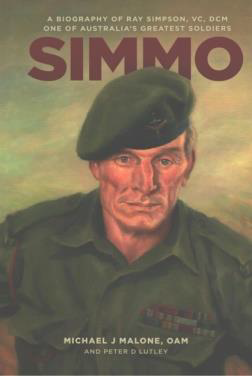SIMMO covers the entire live of Ray Simpson. Born of poor parents in the 20’s, Ray (the eldest) and his four siblings were placed by their parents, who could not afford to feed or clothe them, in kindergartens and eventually in two Methodist Children’s homes.
In 1944 Ray enlisted in the AIF and saw two years’ service in the Second World War. His battalion was used to recapture the Japanese after the August Cowra. Joining the Citizen Military Forces (CMF) in ’47, he then, in 1951 signed up under his brother’s name to join the Australians in the Korean campaign. It was while on leave in Tokyo that he married his Japanese wife, Shoko Sakai, who remained in Japan until Ray was again on service in the Malayan Emergency.
Ray was an avid reader of military books and would argue military tactics with anyone. He lived by the creed of life’s experience and not making the same mistake twice. Ray was extremely loyal to his diggers and preferred to socialize with them rather than his peers. As a member of 1 Special Air Services Company (SAS), he was one of 30 selected veterans in the inaugural Australian Army Training Team Vietnam (AATTV) in 1962 under Brigadier Ted Serong. In 1964 he was in 1 Commando Company when he did his second Vietnam tour. He was awarded the Distinguished Conduct Medal, before later in the tour suffering a severe gunshot wound that shattered his right femur.
Evacuated back to Australia and medically downgraded, he could not contemplate not being in the middle of the action again, so he set about restoring his fitness before surfacing again in Vietnam. Wangling his way onto various patrols in 1967, he eventually was placed back in the AATTV again – his vast battle experience and leadership capabilities already being legendary. On 6 May 1969 Simpson was serving in Kontum Province on the Laos/Cambodian border as commander of the 232nd Company of the Mobile Strike Force of the 5th Special Forces Group in a search and clear operation when the enemy was encountered in a series of action over six days. Simpson’s leadership and bravery during these encounters earned him the Victoria Cross. During his career Ray had seen over 100 months on active service in four theatres.
Simmo’s VC investiture was in Sydney in May 1970 during a Royal Visit. He was discharged from the Army in the same month. With Shoko in Japan looking after her elderly mother, Ray sent most of his money to her, so was always short of cash. Unfortunately most of his last years were spent as a menial civilian laborer in army depots and camps before dying in Japan at the age of 52 of a malignant lymphoma.
The text is generously punctuated by photographs, and is fully referenced. Included are a selected biography, extracts, a list of interviewees and a nine-page glossary of Simmo’s colorful vernacular.
A long-overdue biography, SIMMO fills a void in Australian military history literature. Readers will not be disappointed in learning about this distinguished ‘soldiers’ soldier’.
Reviewed for RUSI by Neville Taylor, June 2016

Hardback RRP: $65.00 (plus $15 postage)
Contact Royal United Services Institute about this article.






